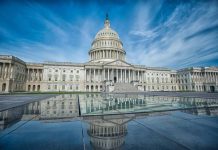
Revised U.S. job growth statistics reveal a staggering 818,000 fewer jobs than initially estimated, painting a grimmer picture of the labor market.
At a Glance
- The U.S. job market was weaker than initially reported for much of 2023 and early 2024.
- Employers added 818,000 fewer jobs in the 12 months ending March 2024 than originally reported.
- Job growth averaged 174,000 per month, down from 242,000 per month.
- The revision supports the Federal Reserve’s plan to cut interest rates soon.
- The biggest downward revisions were in professional services and hospitality industries.
Massive Job Revision Upends Market Perception
The revised statistics from the Bureau of Labor Statistics (BLS) have shown that the U.S. job market is significantly weaker than initially reported, with 818,000 fewer jobs added in the past year. This revision is part of the government’s annual benchmark adjustment to labor market data, using fresh data from the Quarterly Census of Employment and Wages (QCEW). Such a large adjustment is a cause for concern, with job growth now averaging 174,000 per month, starkly lower than the previously estimated 242,000 jobs.
Take a moment to let that sink in — 818,000 jobs vanished into thin air, raising questions about the accuracy and reliability of previous economic reports. Public perception and business decision-making might drastically shift as these figures come to light, necessitating comprehensive measures to address the newly revealed economic challenges.
Implications for Economic Policies and Public Trust
With such a significant downward revision, the Federal Reserve now has more than enough reason to consider cutting interest rates soon. Federal Reserve Chair Powell and his colleagues have often relied on strong payroll data and job openings to gauge economic health. However, these revisions reveal the risks that the labor market has not been as robust as previously indicated.
“The labor market appears weaker than originally reported,” noted Jeffrey Roach, chief economist for LPL Financial, in an email.
The revisions are significantly larger than usual, with a -0.5% adjustment compared to the average +/- 0.1% over the past decade. This discrepancy raises skepticism over whether previous job reports were overly optimistic or intentionally misleading.
Whether professional incompetence or something more nefarious is at play, the public’s trust in government labor statistics is undeniably shaken.
Don't forget that today's massive downward benchmark revision (2nd largest on record) is on top of the existing downward revision to the initial monthly jobs report figures – btwn all the revisions, job growth for the 12-month period was wildly overestimated almost 1.2 million: pic.twitter.com/bZpKQdTVMA
— E.J. Antoni, Ph.D. (@RealEJAntoni) August 21, 2024
Sector-Specific Revisions and Broader Economic Effects
The most affected sectors include professional and business services, with a massive reduction of 358,000 jobs and the leisure and hospitality sector losing 150,000 jobs. Meanwhile, the transportation and warehousing industries are expected to show upward adjustments. This reallocation of data impacts not just statistical accuracy but also economic planning at both micro and macroeconomic levels.
“Overall, the revisions as indicated in this preliminary re-benchmarking are concentrated in a few sectors, with close to 44% concentrated in the professional and business services sector,” Schultz wrote in a note.
Economists believe this weaker jobs data makes a Federal Reserve rate cut in September more likely, albeit by a cautious 0.25 percentage points. However, should the upcoming August jobs report show fewer job additions than expected, the calls for a larger cut will grow louder. We are dealing with a Federal Reserve that raised its benchmark rate 11 times in 2022 and 2023 to combat inflation, now showing signs of pivoting due to these revelations.
Looking Ahead — Trust and Economic Stability
The revised data indicates that only 2.1 million jobs were created in the past year, down from a previously estimated 2.9 million. It highlights serious flaws in how job statistics were reported and analyzed, potentially affecting future economic projections, federal policies, and public trust.
Market reaction to the revision was muted, but the public and policymakers must remain vigilant. The August jobs report, expected on September 6, could either calm waters or stir up a storm. Will this revised data force an acknowledgment of the severe lapses in earlier reports or be brushed under the rug like many failures of the current administration?






















